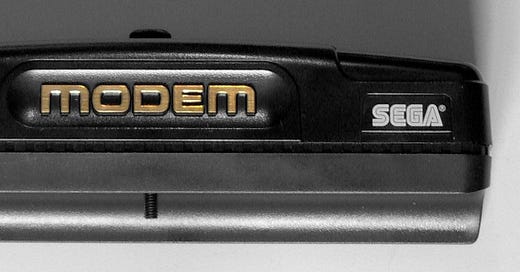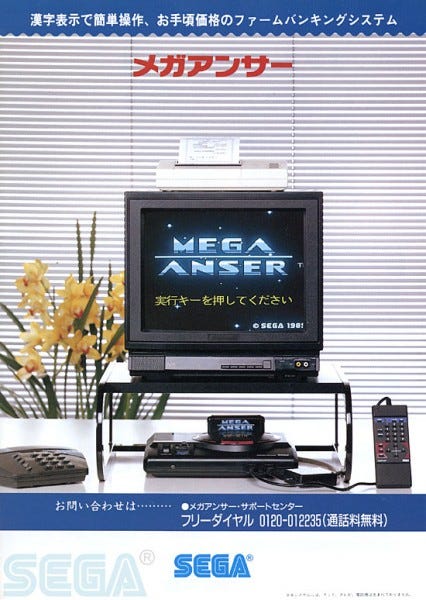The Sega Mega Modem Brought Japanese Gamers Online in the Early 90s
The Mega Drive Lives!
In Japan-Only, we’re discussing games, consoles, and peripherals that – you guessed it – only released in Japan.
In the days of yore, when Sega developed consoles and not just games, the company tinkered, they were never satisfied. Their first console, the SG-1000, came out in 1983, but their first revision for the console – improved in every way – was only a year later, in 1984. Initial SG-1000 games were released on cartridges, but in 1985, Sega released the Card Catcher, a peripheral that allowed Sega to release games on cheaper card-based technology. After its release, most SG-1000 games were distributed as cards from this point on. Also in 1985, Sega released a brand-new console, the Mark III, later known as the Master System in Europe and the States.
In just two years, Sega had released two iterations of the SG-1000, the Mark III, and the Card Catcher, a peripheral that you needed to play the newest SG-1000 games. Unless you had a lotta money, being a Sega fan in Japan was rough.
Sega never participated in such blatant highway robbery again (unless you consider the Sega CD and 32X as such, but at least you didn’t need ‘em to play the latest Genesis games), but they did continue to experiment, particularly in their home market of Japan.
On November 3rd, 1990, Sega released the Mega Modem, an actual modem that connected to the back of your Mega Drive and allowed you to play games with a friend over a dial-up connection. The Modem wasn’t cheap and, given the technology of the time, only five games were even compatible with it. Advanced Daisenryaku: Deutsch Dengeki Sakusen, a turn-based strategy title that requires patience uncommon in most men. CyberBall, which lets you play football with robots in the future. In Shikinjoh, you push mahjong tiles around to clear a path. And finally, Tel-Tel Mahjong and Tel-Tel Stadium let you play mahjong and baseball respectively. Although in the latter, the most you can do is bat and pitch, no infield or outfield play.
Perhaps this selection sounds lame to you, and it is, sort of. If these five games were the Mega Modem’s launch library, fine, so be it. But these are the compatible titles, nothing more. What’s the point of playing with your buddy over the phone if the games just aren’t there?
The reason to own a Sega Mega Modem, such as it was, wasn’t to play two-player titles, but to access Sega’s downloadable game library. If you purchased the Sega Mega Modem, a Game Toshokan cartridge, and a 4800 yen six-month subscription to Sega’s MegaNet service, you could download a number of exclusive Mega Drive titles onto your console. Games like Flicky, Fatal Labyrinth, and a whole bunch of simple one-screen puzzle games and text-based adventures. About 38 games in total were released for the service between 1990 and 1992.
Now, you might be asking, where do these games download to? The Mega Drive never had a memory card and most games let you save right on the cartridge. According to Sega Retro, the “only means of storing downloaded software was in the Mega Drive’s onboard RAM… [this meant] that any software downloads had to be as small as possible.” Hence the proliferation of puzzle/text-based games.
Chances are, if you were a Japanese Sega fan in 1990 and your wallet had survived thus far, you were also an adult with a comfortable salary. Before you headed to the bank and pondered your spending habits, Sega had one more purchase for you: the Mega Anser, banking software that was only compatible with the Mega Modem. If you purchased the Mega Anser cartridge, the printer, and the 10-key pad, you were looking at a $500+ investment for all your home banking needs, not including the cost of the Mega Modem. You could print out your balances, transfer your funds, and hope Sega supported the service beyond a year or two.
Sega had hopes to bring the Mega Modem to the United States, rebranded as the TeleGenesis. They even showed the modem in an ad, claiming that “soon… you’ll be able to play against friends in other cities. Or across town.” Hah! The TeleGenesis would be cancelled, presumably due to low Mega Modem sales in Japan. And while the Sega Channel would expand on what Game Toshokan was attempting to do with an online game library in the mid-90s, it would be a decade later before online console gaming really captured the mainstream.
Sega is brilliant and forward thinking, sometimes too much so. Their ideas are too much, too soon, and their loyal consumers always end up paying the price. The Genesis was hitting its stride in 1992 with Sonic 2. Why release the Sega CD, then? Why release it at all? Surely the Saturn was in development by 1992 and Sega knew it was coming in a couple years? “Screw it, release it, our fans will buy it,” must have been the prevailing wisdom. I don’t know what they were thinking.
At least with the Modem, they saw the future, they just got ahead of themselves a little bit. It wasn’t hubris, just wishful thinking. A desire to move the world forward without counting the cost.
*images courtesy of SegaRetro








Sega always seemed determined to get on the ground floor of technology.